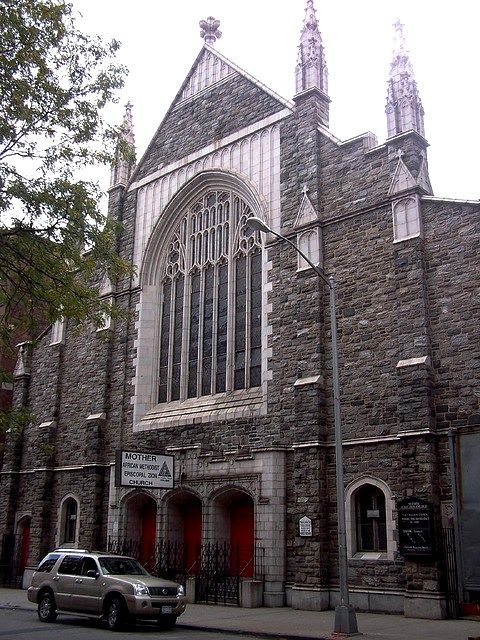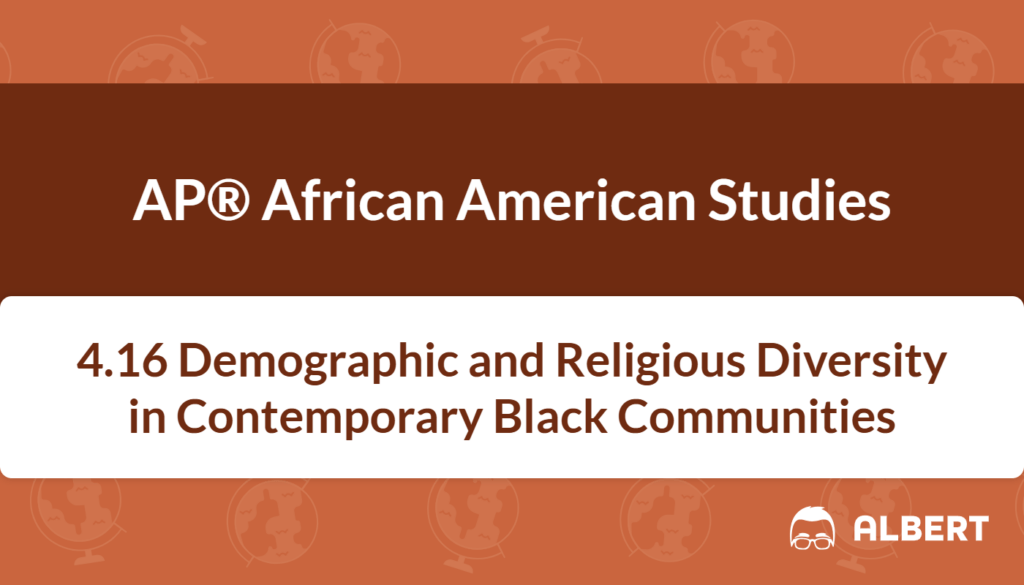What We Review
Demographic and Religious Diversity in Contemporary Black Communities
Demographic and religious diversity in Black communities is a central topic in AP® African American Studies. Understanding how Black populations have grown, diversified, and supported one another through faith is critical for appreciating the broader African American experience. This article explores population changes since 2000, examines the role of religious traditions, and explains why “Black” is such a unifying term. These insights fulfill Learning Objectives (LO) 4.16.A and 4.16.B by showing how the Black population has both expanded and diversified, while faith communities have continued to serve as vital social and educational hubs.
Introduction
Black communities in the United States are not a monolith. They have evolved in dynamic ways, particularly since 2000. The increase in the Black-identifying population includes more college graduates, more Black immigrants, and more people identifying as multiracial. Meanwhile, faith traditions have guided social movements and kept communities strong. Therefore, understanding this growth and diversity provides a clearer picture of Black experiences and unites people across various backgrounds.
Growth and Diversity of the Black Population Since 2000
Overview of Population Growth
Between 2000 and 2019, the Black-identifying population in the United States grew by 30%. According to course standard EK 4.16.A.3, this population rose to about 47 million people, or nearly 14% of the national total. This growth affects areas such as politics, education, and culture.
- Many urban communities have witnessed a spike in Black-led small businesses.
- Suburban areas have also seen increases in Black families, influencing local school systems and community resources.
The growth of Black communities has also brought attention to voter representation, workplace dynamics, and neighborhood development. Consequently, these demographic changes reflect a need for policymakers and educators to address new challenges and opportunities.
Educational Attainment
Since 2000, the number of Black college degree holders has more than doubled (EK 4.16.A.1). This achievement opens up a wider range of career opportunities, particularly in science, technology, engineering, and mathematics (STEM) fields. It also encourages entrepreneurship, as more graduates explore starting their own businesses.
However, the soaring number of Black Americans with college degrees also highlights the importance of mentoring and networking. The next wave of national leaders often emerges through these academic experiences, bringing fresh ideas and inspiration to Black communities. These accomplishments strengthen families and generate social and economic improvement.
Rise of Black Immigrants
Another critical factor is the nearly doubled number of Black immigrants, mainly arriving from Africa and the Caribbean (EK 4.16.A.2). These immigrants bring distinct cultures, languages, and traditions that add new dimensions to Black life in the United States. At the same time, shared African heritage unites many Black Americans born in the U.S. and those arriving from abroad.
For example, Nigerian and Haitian communities often host cultural festivals to celebrate their customs and connect with others. These celebrations encourage cultural exchange, fostering appreciation and respect for both African and Caribbean heritages.
Increasing Multiracial Identification
Furthermore, the number of people identifying as Black and Hispanic or otherwise multiracial has grown significantly (EK 4.16.A.2). Many families include members who identify with mixed ancestries, often bonding over both African and Latin American traditions. This development demonstrates how identity is not always a simple category but can be shaped by multiple cultural influences.
Teachers and leaders are paying closer attention to this trend by rethinking the curriculum. They often incorporate diverse literature and history lessons, reflecting the growing complexity of Black identities. As a result, students of all backgrounds learn how identity can transcend labels and include varying dimensions.
The Role of Religion in Black Communities
Overview of Religious Affiliation
Religion remains a key element in many Black communities. In the early twenty-first century, about two-thirds of African American adults identify as Protestant, while 20% have no specific religious affiliation (EK 4.16.B.1). Black churches continue to be vital community anchors, offering not only spiritual guidance but also educational programs and social services.
However, there is a rise among young Black adults who identify as non-religious. This shift suggests that spiritual expressions are becoming more varied. Some individuals practice Islam, African traditional religions, or choose secular perspectives while still remaining committed to social justice and community uplift.
Advocacy Through Faith

Black religious leaders have held prominent roles in civil rights movements throughout history (EK 4.16.B.2). During the modern era, these faith leaders still mobilize congregations to support voter registration drives, protest racial inequality, and lobby for equitable policies. For instance, many Black churches sponsor educational workshops that teach community members about financial literacy, health advocacy, and civic engagement.
In many neighborhoods, faith communities organize marches against social injustice or gather supplies for victims of natural disasters. These actions speak to the influential role of religion, particularly Protestant denominations, in fostering activism and hope.
The Black Church as a Community Hub
The Black church has long been recognized as an institutional home for dialogue around critical community issues (EK 4.16.B.3). Beyond sermons, these churches often serve as meeting places where:
- Parents discuss local school reform.
- Students explore scholarship opportunities.
- Community organizers plan cultural events.
Since churches regularly draw people together in a spirit of fellowship, they create environments where differences are set aside, and unity is emphasized. Black churches have also nurtured music traditions like gospel singing, which inspire artistic creativity and encourage self-expression. Therefore, these institutions remain crucial for bridging generational gaps and highlighting cultural legacies.
The Shared Identity of Black Communities
Understanding the Term “Black”
The term “Black” unites people of African heritage, yet it includes diverse cultures and experiences (EK 4.16.A.4). Descendants of the formerly enslaved in the United States may identify as African American, Afro-Latinx individuals might emphasize their Latin American roots, and immigrants from Africa or the Caribbean often highlight their national origins.
Nevertheless, these separate identities overlap through various shared elements:
- Ancestors originated from the African continent.
- Experiences of discrimination (and triumph over adversity) shape collective narratives.
- Cultural expressions—such as dance, music, and cuisine—often stem from African influences.
When combined under the umbrella of “Black,” these varied heritages underscore both unity and individuality.
Shared Experiences and Heritage
In addition to ancestry, many Black Americans share historical struggles and victories. This might include the Civil Rights Movement, which connected individuals across class, religion, and national origin. Modern movements for racial justice continue that legacy, with Black immigrants, African Americans, and multiracial families working together to challenge inequalities.
Therefore, African heritage fosters resilience, creativity, and solidarity among Black communities. Cultural celebrations like Kwanzaa demonstrate this unity by highlighting African traditions and core principles, such as self-determination and cooperative economics. These gatherings serve as powerful symbols of the past and guide people toward a purposeful future.
Conclusion
Demographic and religious diversity in Black communities underscores the depth of African American history. Since 2000, the population has expanded and become increasingly dynamic: more college graduates, rising numbers of Black immigrants, and growing multiracial identification. At the same time, faith communities continue to anchor social progress, nurture leaders, and unite families across lines of difference.
In AP® African American Studies, these themes remind students that “Black” is much more than a single identity. It is a term that carries a shared heritage of resilience, innovation, and unity. Exploring these layers offers fresh insights into how individuals and groups adapt and thrive, even when confronted with challenges. A commitment to understanding this diversity helps create inclusive spaces for dialogue and community building.
Sources
- Tamir, C. (2021). “The Growing Diversity of Black America.” Pew Research Center.
- Pew Research Center. (2021). “Young Black Adults Less Protestant than Their Elders.”
These sources provide statistical data and analysis on shifts in the Black population’s demographics and religious affiliations. They support Learning Objectives 4.16.A and 4.16.B by showing how the Black population has diversified in education, immigration, and identity, and by highlighting how faith communities remain influential in African American social, political, and cultural life. The historical context and survey findings help illustrate how Black churches have been essential for community building, especially in the early twenty-first century.
Quick Reference Chart
Below is a quick reference chart with important vocabulary and definitions related to demographic and religious diversity in Black communities.
| Term | Definition |
| African American | An ethnonym often used by descendants of those enslaved in the U.S. |
| Afro-Caribbean | Individuals of African descent with origins in Caribbean nations. |
| Black Churches | Predominantly African American Christian congregations serving as social and religious hubs. |
| Black Immigrants | Individuals of African descent who have arrived from other countries, including various nations in Africa and the Caribbean. |
| Demographic Diversity | The variety of backgrounds, nationalities, and identities within a population. |
| Educational Attainment | The level of education completed by individuals, such as high school diplomas or college degrees. |
| Multiracial Identification | Identifying as belonging to more than one racial or ethnic group. |
| Protestant | A branch of Christianity that includes denominations such as Baptist, Methodist, and Pentecostal. |
| Social Justice Advocacy | Efforts made by individuals or groups to address and rectify social inequalities. |
Sharpen Your Skills for AP® African American Studies
Are you preparing for the AP® African American Studies test? We’ve got you covered! Try our review articles designed to help you confidently tackle real-world AP® African American Studies problems. You’ll find everything you need to succeed, from quick tips to detailed strategies. Start exploring now!
Need help preparing for your AP® African American Studies exam?
Albert has hundreds of AP® African American Studies practice questions, free response, and full-length practice tests to try out.









